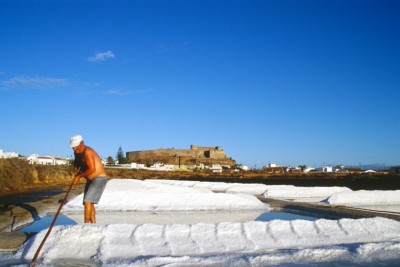Description: Sal de Castro Marim / Flor de Sal de Castro Marim is the sea salt obtained in the traditional salt marshes of Castro Marim, using manual processes. It is an unrefined, unrefined dietary salt after harvest, not chemically transformed and without additives, rich in mineral salts and marine oligoelements.
Depending on the training conditions and the harvesting method, Sal de Castro Marim / Flor de Sal de Castro Marim is presented as:
Sal de Castro Marim
It is a solid body whose main characteristic is its naturally pure bright white color. It is presented in the form of transparent cubic crystals, of variable dimensions, which are organized in small flakes, typically in the form of an inverted pyramid, which can be broken by handling. It dissolves easily without leaving significant residues.
It is also obtained in the form of liquid salt, extracted from the water of the salt cuttings during the crystallization of the salt or at the end of the harvest. Castro Marim's liquid salt is colorless, transparent, dense, and slightly viscous, with an intense salty and bitter taste, resulting from a high concentration of magnesium and other marine mineral salts.
Flor de Sal de Castro Marim
It is a thin film that forms on the water surface of crystallizers, being the first saline product to form as soon as the water reaches the saturation necessary for the start of crystallization. It is presented in the form of small crystals, which can be confused with ground salt, but lighter, arranged in small fragile sheets, formed during the precipitation of the salts, which float on the surface of the crystallizer and break with handling.
The Sal de Castro Marim can be presented as it is or ground and both the «Sal de Castro Marim» and the Flor de Sal de Castro Marim can be flavored using natural smoking, mixtures of spices and / or herbs aromatic and with liqueur wine, and then packed in containers for sale to the final consumer.
Production method: With the beginning of the crystallization that occurs in the butchers, Flor de Sal de Castro Marim and Sal de Castro Marim are collected. The Flor de Sal de Castro Marim is the first product to form, once the water reaches the saturation necessary for the start of crystallization. Crystallization has started and in view of the reduction in the volume of water that occurs in the butchery due to evaporation, it is again fed with water. After 4 to 7 weeks, depending on climatic conditions, the "Sal de Castro Marim" is removed.
Special features: The physical characteristics of Sal de Castro Marim / Flor de Sal de Castro Marim result from the high speed of crystallization, the low amount of insoluble matter present and the knowledge accumulated in the manual processes of maintenance of salinas, water management and collecting the salt. The low amount of insoluble matter is closely linked to the natural water decantation process, the density of soil clays and the intensity of the wind recorded during the harvesting of the salt, which is, as a rule, softer and more constant at this time, therefore, it does not drag a large number of particles onto the surface of the crystallizer. Another factor that explains the whiteness of this salt is the height and vegetation of the salt walls, which protect the crystallizers from the wind. The combination of these factors makes the sea salt and the extra salt flower have little impurity, thus maintaining its natural whiteness.
Geographical area: The salt flats of Sal de Castro Marim / Flor de Sal de Castro Marim are located in the Natural Reserve of Sapal de Castro Marim and Vila Real de Santo António. Administratively, the defined geographical area is circumscribed to the parishes of Castro Marim, Vila Real de Santo António and Monte Gordo.
History: The «Sal de Castro Marim» / «Flor de Sal de Castro Marim» is characteristic of its origin, being the result of the specific climate of the place, the constitution of the saline soils and its mineral richness achieved by the centenary continuous production of salt, of the content minerals and salt water purity from this location and the locally perfected manual process over centuries used to obtain and preserve its characteristics.
In Roman times, between the 1st and 4th century AD, salt appears associated with fish processing centers on the Algarve coast. The first written reference on the salt of Castro Marim dates back to the late Middle Ages and corresponds to the first Charter of Charter, granted by D. Afonso III, dated 8 July 1277.
Product specifications (pdf)
Producer group
Terras de Sal - Comércio e Transformação de Sal Marinho Artesanal CRL
Control and certification body
Kiwa Sativa – Unipessoal, Lda.
Control plan
Control plan (pdf)
Publication in EU official journal
Publication in the Portuguese official journal
Despacho n.º 6105/2020 - 05.06.2020



